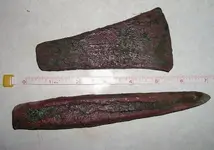IllinoisDoug...
I'm not certain that a chemical test ket would clearly identify what you have, mainly because copper can have a variety of compositions on the surface after being exposed to the environment. It's very likely a combination of oxidized copper, copper sulfide and copper carbonate (the greenish patina) and I don't know how those test kits react with different compounds
Oroblanco is correct that you can try to determine the density of the items by using water - the one caveat to that is that you have to be very accurate in your weights and volumes of displaced water, if you're not, you won't be able to distinguish accurately between the different densities and you might make the wrong assessment.
For example: Assume that the axe head looking item weighs 1 pound (453.6 grams). If you place it in a container of water , it would displace ~50.6 milliliters if it was pure copper and ~57.4 milliliters of water if it was bronze. Unless you have very accurate balances and means for measuring volume, that 6.8 milliliter difference is awfully small to detect - add in the fact that you have to make sure you don't lose any of the water that was displaced and a few other places for error and your odds of getting the right number aren't great.
I know you don't know me from Adam, but I happen to work in a laboratory with access to an instrument that can be used to determine the chemical composition of all sorts of items. I have a copper spear head which I had someone check for me to make sure it was copper and it came out as exactly that (it also showed some small amounts of carbon, oxygen, sulfur and other things one would expect to be on something from the ground). If you want to look up the instrument, do a search on Scanning Electron Microscope with Energy Dispersive X-Ray capability (SEM EDX). Because we have one in our lab, I'm lucky enough to be able to talk my fellow microscopist into looking at some of the things I find to determine if they are gold, silver etc...
I certainly can't get into the habit of inundating them with things to look at because they have plenty of other work to do, but they get a kick out of looking at different things too and do it when they have a few free minutes for me. If you would like, I would be willing to have them check those things out for you - as I said, you have no reason to trust me except for the fact that I'm a fellow TH'r. All I can do is make the offer and tell you that you have my word nothing would happen to them to damage them and I would return them as soon as they were analyzed. If you're interested, send me a PM and we can chat on the phone or e-mail or whatever.
I totally understand if you would rather not do this - to tell you the truth, I'm not sure I would trust someone I don't know with my items either. I don't make this offer to everyone because as I said, I don't want to lose my priveledges by taking advantage of my co-workers, but in this case I've always been interested in copper age artifacts and would be happy to help you identify yours.
paul


